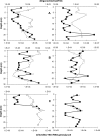Natural niche for organohalide-respiring Chloroflexi
- PMID: 22101035
- PMCID: PMC3255752
- DOI: 10.1128/AEM.06510-11
Natural niche for organohalide-respiring Chloroflexi
Abstract
The phylum Chloroflexi contains several isolated bacteria that have been found to respire a diverse array of halogenated anthropogenic chemicals. The distribution and role of these Chloroflexi in uncontaminated terrestrial environments, where abundant natural organohalogens could function as potential electron acceptors, have not been studied. Soil samples (116 total, including 6 sectioned cores) from a range of uncontaminated sites were analyzed for the number of Dehalococcoides-like Chloroflexi 16S rRNA genes present. Dehalococcoides-like Chloroflexi populations were detected in all but 13 samples. The concentrations of organochlorine ([organochlorine]), inorganic chloride, and total organic carbon (TOC) were obtained for 67 soil core sections. The number of Dehalococcoides-like Chloroflexi 16S rRNA genes positively correlated with [organochlorine]/TOC while the number of Bacteria 16S rRNA genes did not. Dehalococcoides-like Chloroflexi were also observed to increase in number with a concomitant accumulation of chloride when cultured with an enzymatically produced mixture of organochlorines. This research provides evidence that organohalide-respiring Chloroflexi are widely distributed as part of uncontaminated terrestrial ecosystems, they are correlated with the fraction of TOC present as organochlorines, and they increase in abundance while dechlorinating organochlorines. These findings suggest that organohalide-respiring Chloroflexi may play an integral role in the biogeochemical chlorine cycle.
Figures



References
-
- Abrahamsson K, Ekdahl A, Collén J, Pedersén M. 1995. Marine algae—a source of trichloroethylene and perchloroethylene. Limnol. Oceanogr. 40:1321–1326
-
- Adrian L, Hansen SK, Fung JM, Görisch H, Zinder SH. 2007. Growth of Dehalococcoides strains with chlorophenols as electron acceptors. Environ. Sci. Technol. 41:2318–2323 - PubMed
-
- Adrian L, Szewzyk U, Wecke J, Görisch H. 2000. Bacterial dehalorespiration with chlorinated benzenes. Nature 408:580–583 - PubMed
-
- Bedard DL. 2008. A case study for microbial biodegradation: anaerobic bacterial reductive dechlorination of polychlorinated biphenyls—from sediment to defined medium. Annu. Rev. Microbiol. 62:253–270 - PubMed
Publication types
MeSH terms
Substances
Associated data
- Actions
- Actions
- Actions
- Actions
- Actions
- Actions
- Actions
- Actions
- Actions
- Actions
- Actions
- Actions
- Actions
LinkOut - more resources
Full Text Sources
Other Literature Sources

